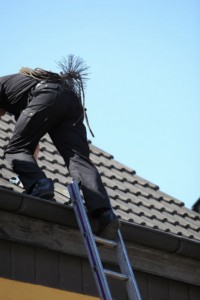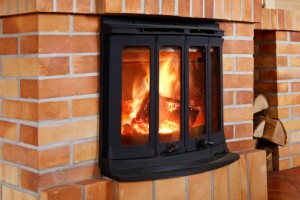During the cold months of winter, homeowners rely on their fireplaces to work day in and day out in order to provide warmth and comfort in their homes. However, few us of truly understand the inner workings of our chimney and fireplace systems; because of this, small damage or performance problems may go unnoticed for months – or years – at a time.
Because few of us spend much time on our roofs or looking up the flue, chimney damage often goes unnoticed until a chimney inspection. A chimney inspection done by a certified chimney professional can assess the state of your fireplace system, identify areas of damage or deterioration, and allow recommendation for repairs to be made.
Levels of chimney inspection
The Chimney Safety Institute of America (CSIA)] and the National Fire Protection Agency (NFPA) created three standard levels of chimney inspections; the type of chimney inspection your home needs will depend on its condition, time since last maintenance, or performance problems it may be experiencing.
- Level 1: Level 1 chimney inspections are standard and all that is needed for most homes. During a Level 1 inspection, the chimney sweep will check the accessible interior and exterior portions of the fireplace and chimney for signs of damage or deterioration.
- Level 2: Level 2 chimney inspections are more in-depth, typically involving the use of technology such as closed-circuit cameras. Level 2 inspections are often recommended in real estate transactions or when the fuel source of a fireplace has been changed.
- Level 3: Level 3 chimney inspections are the most in-depth and only recommended when the structural stability of the chimney is in question, such as after a chimney fire or natural disaster. A portion of the masonry or walls may need to be removed during a Level 3 inspection.
Common issues uncovered in chimney inspections
- Every fireplace system and every chimney inspection are unique; however, there are a number of common issues that are often uncovered during an inspection. The following are three of the most common chimney issues uncovered during inspections.
- Water damage. Chimneys are built to withstand exposure to moisture, but it can still be extremely damaging to a fireplace system. Damaged chimney caps, cracks in the exterior masonry, or damaged flashing are just a few of the many ways water can get into a chimney.
- Cracked chimney crown. Chimney crown damage is extremely difficult to spot without climbing onto the roof or chimney. The flat masonry of the chimney crown bears the brunt of the exposure to the elements; changes in temperature or exposure to moisture can cause the chimney crown to crack over time.
- Damaged chimney liner. The chimney liner protects the surrounding building materials from heat transfer from the fireplace. Liners can become damaged from animal entry, leaks, lack of maintenance, or debris in the chimney.
Preventative maintenance is one of the best ways to extend the life of our fireplaces and chimneys. An annual chimney inspection done by a certified chimney professional can uncover hidden issues that many homeowners might not otherwise notice. For more information on the importance of chimney inspections or to schedule your next chimney appointment, contact Jack Pixley Sweeps today!
As gas and oil appliances become more efficient and cost effective, more and more homeowners are opting to convert their open hearth fireplaces to gas and oil. While these new fireplace units offer minimal maintenance and are easier to operate, changing the fuel type of your fireplace may damage your chimney.
Even if your new fireplace fits into the firebox, it may not be a good fit for the chimney. Because of this, it may be recommended to have your chimney relined after installing a new fireplace unit.
Types of chimney liners
There are a number of reasons it may be recommended that you have your chimney relined, including missing a liner entirely, having a damaged chimney liner, or switching to a fireplace with a different fuel source. When having your fireplace relined, there are three main types of chimney liners: clay tile, cast in place, and metal liners.
- Clay tile liners: Clay tile liners are the standard material used for lining chimneys. Clay tiles are extremely durable and can last for 50 years or longer when correctly installed and properly maintained. However, just like your chimney a clay tile liner has masonry joints that are more susceptible to damage. Likewise, it is virtually impossible to replace cracked or broken tiles within the flue without removing a portion of the chimney.
- Cast in place liners: Cast in place liners are built using one of several poured cement processes. The lining material is literally cast directly into the flue, molding to the exact shape and size of your chimney while creating a seamless liner. Because of the insulation provided by a seamless liner, cast in place liners are known to reduce creosote accumulation and burn cleaner. Likewise, cast in place liners are can be used to reinforce a damaged chimney structure.
- Metal liners: Stainless steel liners are favored by many in the fireplace industry because of their ease of installation and durability. Likewise, stainless steel liners are available in a variety of different sizes to ensure that the flue is correctly sized for your fireplace unit. Many stainless steel liners come with a limited lifetime warranty when swept and inspected annually.
Why your old chimney may need a new lining 
Most homeowners associate having the chimney relined with damage such as a chimney fire. However, what they may not realize is that switching fuel sources can also necessitate having the chimney relined.
Fireplaces need to have a correctly sized flue in order to operate with maximum efficiency. If the flue is too big for the fireplace it will not vent properly, decreasing efficiency and leading to increased creosote buildup in the chimney. Likewise, many clay tile liners are not built to withstand the byproducts of an oil or gas fire. While wood burning fires produce creosote, gas and oil fires create a corrosive, acidic condensate. This condensate can eat away at clay tiles, causing them to quickly deteriorate. Instead, a stainless steel liner should be used to protect the rest of your home and chimney from this acidic buildup.
Whether you’re switching fuel sources or simply installing a more modern unit, your flue may no longer be correctly sized for your fireplace. Call Jack Pixley Sweeps today to learn more about how relining your chimney can improve the efficiency and safety of your new fireplace.

Jack Pixley Sweeps services wood burning inserts!
In our busy, fast paced lives, many homeowners find that they no longer have the time or energy to use their wood burning fireplaces. Instead of letting the fireplace become a purely decorative part of the home, considering installing a fireplace insert.
Fireplace inserts minimize maintenance while still allowing you to enjoy the look and feel of a wood burning fire. Below are the top five reasons why you should considering installing a fireplace insert.
Improved efficiency
While wood burning fireplaces create a wonderful ambiance, they are not very efficient heating sources. Most fireplaces have efficiency ratings as low as 5-10% due to the open combustion of the burning process. Fireplace inserts, however, are sealed systems. This creates more complete combustion, a more efficient fire, and less energy loss. The Hearth, Patio, and Barbeque Association has reported that in some cases, installing a fireplace insert can reduce energy bills by as much as 40%.
Different fuel choices
With a wide variety of fuel choices available, there is a fireplace insert to meet every need. There are available inserts that burn coal, natural gas, pellets, propane, and even wood. Those looking for fires at the press of a button may opt for a gas insert, while others may choose a wood burning insert for a more traditional look and feel. The freedom to choose your fuel source gives homeowners the ability to find an insert that best meets their needs.
Minimize masonry repairs
If your firebox has been damaged, fallen into disrepair, or needs extensive renovations, installing a fireplace insert may be a way to let you continue to use and enjoy your fireplace without the hassle of a complete rebuild. Because the fireplace inserts are placed directly into the existing firebox, they can be installed and used even if the masonry of the old firebox has been damaged.
Fireplace inserts should always be professionally installed to ensure that they are placed correctly. In some cases, the flue may need to be altered to accommodate the new insert. New stainless steel chimney liners can easily be installed to ensure that the flue is the right size for your fireplace insert.
Environmentally friendly
Unlike traditional wood burning fireplaces which cannot be certified by the EPA, fireplace inserts are required to be EPA certified. This certification shows that your insert produces a minimal amount of particulate emissions and has a smaller impact on the environment. Because of their closed system combustion, most fireplace inserts are able to reduce emissions to almost zero.
Stylish designs
In addition to being able to choose their fuel source, homeowners switching to a fireplace insert can also select the aesthetic style of their new heating appliance. Inserts come in a variety of styles from the contemporary to the modern, and there are inserts to fit every style and budget.
If you’re tired to the work and maintenance required with a wood burning fireplace, a fireplace insert might be the right choice for you. Inserts can improve efficiency, reduce costs, and turn a damaged or unsightly firebox into the focal point of your room. For more information on fireplace inserts, contact the expert staff at Jack Pixley Sweeps today!
Fireplaces continue to be beautiful additions to many homes. Additionally, many homeowners find that they rely on them in winter to add warmth and comfort to their homes.
Despite their popularity and widespread use, most people do not understand how their chimneys work. This can sometimes lead to homeowners misidentifying the cause of an issue or not realizing it is time for maintenance.
The following are some of the most important components of your chimney that many people are unfamiliar with. Learning more about the anatomy of your chimney can help you identify and understand any chimney issues you may have in the future.

Chimney cap
The chimney cap covers the top entrance of your flue, allowing smoke to safely exit while preventing water, animals, and debris from getting in. Uncapped chimneys or those with damaged caps are more likely to have issues with water damage, blockages, or animals nesting in the chimney.
Chimney crown
A chimney crown is a slab, typically made of concrete, which protects the masonry of your chimney. Damaged chimney crowns may allow water into the chimney structure or allow the masonry of the chimney to receive water damage.
Chimney chase cover
Similar to a chimney crown, a chimney chase cover protects the top of the chimney. Typically made of metal, chase covers were used regularly in the 1970s and 1980s with factory built or prefabricated chimneys. Over time, chimney chase covers may deteriorate, causing rust stains on the masonry of the chimney.
Chimney damper
The chimney damper separates the firebox from the flue. Open and closed using a pulley or a lever, the damper prevents heated or air conditioned air from escaping as well as minimizing drafts. Likewise, dampers help prevent moisture, debris, or animals from getting into the firebox. While dampers should be closed when the fireplace is not in use, the damper should always be opened before starting a fire to prevent smoke from backing up into a room.
Chimney flue
The chimney flue is the chamber through which smoke, gas, and other byproducts of combustion are vented to the outside.
Chimney flue lining
Chimney flue liners protect the surrounding building materials from the hot air, smoke, gas, and other byproducts of combustion that are travelling up the flue. There are three main types of flue linings: clay tiles, metal, or cast in place. Over time, creosote can build up on the flue lining. This byproduct of combustion is highly flammable, and it’s removal is the primary purpose of annual chimney sweepings.
Smoke chamber
The smoke chamber is designed to help compress smoke from the firebox into the flue without creating a backdraft. Smoke chambers are created with a sloping wall just above the firebox. A well designed smoke chamber with allow smoke, gas, and other byproducts of combustion to smoothly and quickly travel up the flue.
Smoke shelf
Located behind the damper, the smoke shelf is designed to catch any water or debris that enters the chimney. The smoke shelf also helps compress the large amounts of smoke created in the firebox to the much smaller entrance to the flue.
Chimneys are complex structures with a number of working parts that must be kept up in order to keep your fireplace working well. Contact the experts at Jack Pixley Sweeps today to schedule a sweeping and inspection to ensure your fireplace and chimney are in prime condition.

Jack Pixley Sweeps uses a chim-scan camera on each chimney flue 6″ or greater
When one of our Chimney Safety Institute of America (CSIA)-certified technicians from Jack Pixley Sweeps visits your home to perform your annual chimney inspection, we are certain you will be impressed and very satisfied with our special touch to the inspection: the Chim-Scan Closed Circuit Internal Evaluation System. Without this video technology, the inspector cannot see every inch of your chimney’s interior. Nor can he show you exactly what is wrong with your chimney. With the Chim-Scan camera, we can examine every area of your chimney, and we will show you the video footage after the inspection and explain our findings to you. We would like to tell you more about this phenomenal technology and why an inspection using the closed circuit Chim-Scan camera is so much better than one without this technological tool.
What Is a Chim-Scan?
According to the Estoban Foundation, the company that developed and manufactured this product, a Chim-Scan is a remote imaging apparatus designed to be raised or lowered into a chimney that provide the viewers, such as the chimney inspector and the homeowner, the ability to see every inch of the interior of a chimney up close. Via the Chim-Scan Closed Circuit Internal Evaluation System, the inspector and the homeowner have a view of areas that cannot be seen by regular visual means.
Why Is Using a Chim-Scan During a Chimney Inspection So Important?
Since the Chim-Scan camera can see every inch of your chimney’s interior, we may discover damage that would have been missed without a Chim-Scan. Damage to the inside of your chimney typically needs repairing before your fireplace can be safely used. Cracks in any part of your flue allow the toxic gases from combustion to leak out into your home. If you continue to have fires when your flue is cracked, you run the risk of further cracking due to parts of the flue not being protected from the heat of combustion. A Chim-Scan can also provide you with photographic and/or video evidence of damage if needed for insurance purposes.
What Are Other Benefits of the Chim-Scan Closed Circuit Internal Evaluation System?
Not only does a Chim-Scan find “hidden” flue damage, but it can also be used to diagnose chimney fire damage, find “patch” jobs done by amateurs, and indicate the presence of animals and/or their nests inside a chimney. Especially important after a chimney fire, it can help indicate the cause of the fire, how much damage occurred in the fire, and thoroughly document the situation for an insurance claim. After the scan has been conducted, there are different types of media you may receive including written reports, pictures, and video recordings.
Are you interested in the most thorough chimney inspection you can have? Contact Jack Pixley Sweeps to schedule your annual chimney inspection with the benefits of a Chim-Scan camera.




